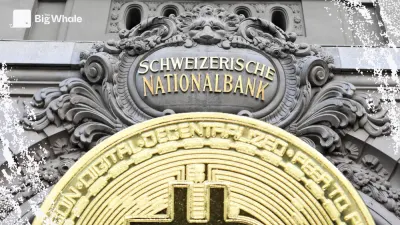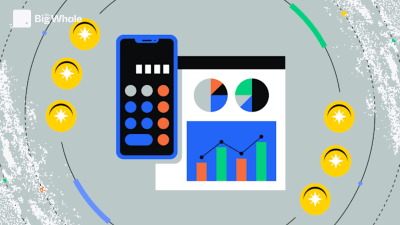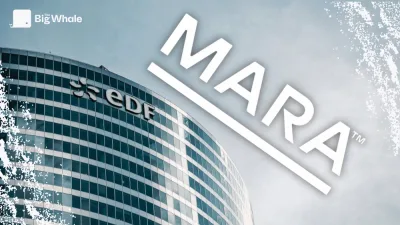TBW - Guy de Leusse (ODDO BHF): "EUROD holders will be able to generate onchain returns".

The Big Whale: You've just launched your stablecoin, EUROD, a project that ODDO BHF has been working on for over two years. Why this launch now? Have the announcements of other projects, in particular European consortia, prompted you to accelerate?
Guy de Leusse: As you know, we've been interested in the world of digital assets for a long time (ODDO BHF invested in Coinhouse in 2022, editor's note) and stablecoins are part of that world.
The subject of stablecoins caught our attention in 2022-2023. We said to ourselves that things were happening and that we should take a look. We met a lot of players and start-ups. At the time, I was on the asset management side.
Asset management is a product business: making products, marketing them.
We started thinking about stablecoins, telling ourselves that it was the simplest product to explain, the most accessible, and probably the best way to enter the crypto ecosystem and work with all its players: exchanges, brokers, market makers, asset managers. These are players with whom we have no relationship today, even though the potential is considerable.
Quite quickly, we decided to launch ourselves, and it seemed obvious to us that it would be a euro stablecoin. In our view, there was no reason or legitimacy for the dollar. We are a European bank, convinced of Europe's potential.
The other important point is that the euro stablecoin market is virtually non-existent, everything has to be done. The dollar stablecoin market, on the other hand, is saturated; market share has already been taken. Maybe some US banks can compete with Tether and Circle on dollars, but for ODDO BHF, it's a near-impossible mission.
Will there really be a euro stablecoin market? Do we simply have to be patient, or does this raise the question of whether this market could actually emerge one day?
I think it will happen for two reasons.
The first is that in the banking business, when a client buys shares in IBM or Nvidia, they buy them in euros, they pay in euros. When they sell, we do the exchange and our client comes back in euros. He doesn't first position himself in a dollar account to invest in US stocks, because when he wants to withdraw and return to cash, he doesn't put himself in dollars, otherwise he takes a bet on the dollar.
The second reason is that over the last year, we've seen a change. If you look at the capitalisations of euro stablecoins since MiCA came into force at the beginning of July 2024, the euro's capitalisation has already more than doubled (from €190 million to €430 million).
It's still incomparable to the dollar, but in terms of percentage and growth, it's a fast-growing market.
Why did it take so long to launch EUROD?
Because internally, I really wanted to make sure that everyone understood and that everyone was aligned. When I say everyone, I really mean everyone.
We're a family-run, entrepreneurial business with a board of directors that had to be made completely comfortable with the subject. It's something completely new for us.
And then what many people don't see from the outside is that banks have processes. We have to go through new product committees to approve the launch of a new product. We've done more than three of these. I've been with ODDO for 30 years and this has never happened to me (laughs), but it was normal because it's a real shift.
On the technical side, have you made any differentiating choices with this stablecoin?
We made the choice to start on Polygon (second-layer blockchain on Ethereum). It's a slightly different choice to the others. We chose Polygon first because they're in Proof of Stake and because it's an EVM-compatible blockchain.
Subsequently, we'll be able to port the smart contract without any problem to other EVM-compatible blockchains, notably Ethereum if tomorrow we want to deploy directly on Ethereum.
In addition to Polygon's compatibility with other blockchains, there's also the cost aspect. We know that costs on Ethereum are unpredictable. From one day to the next, you can be charged €20 for the slightest transaction. Launching on Ethereum called into question the whole argument that we were lowering costs thanks to the blockchain.
At the same time, the Ethereum ecosystem is much more developed than Polygon's...
You're right, but we also know that when a stablecoin is launched, the majority of exchanges take place on crypto platforms. On an Exchange, whether it's on Polygon, Ethereum or any other blockchain, there's really no difference.
If in three months' time we need to be on another blockchain - Ethereum, Solana or others - we're completely open and ready to evolve. That's what all the other stablecoins are doing.
You chose Bit2Me as your first partner for the EUROD listing. Why this exchange? How was this choice made? Are there any other partnerships planned for the coming months?
We chose Bit2Me mainly for their interesting volumes in euro stablecoin. Bit2Me is a Spanish platform that also operates in South America, with remittance flows in stablecoin. They are MiCA-regulated and therefore comply with the same compliance and regulatory rules as us and the Spanish banks.
We could have chosen more international players, but we think that to promote the euro, European players are best placed. Today, we have started with Bit2Me in Spain. Tomorrow, we'll be working with players in France, then Germany, and so on.
Will everyone be able to access your stablecoin, from retail to corporate? Is there no particular KYC or KYB system?
Yes, everyone. We carry out checks on distributors and maintain a blacklist of wallets, those blocked by the Financial Action Task Force (FATF).
In terms of distribution, what type of customer do you want to reach? What will the next 6 to 12 months look like?
In the first instance, we will be targeting players already present in the crypto ecosystem, those who want to protect themselves from market risk by switching to stablecoin rather than fiat. This is the most obvious and useful use for many crypto investors.
Our vision for the development of a stablecoin is based first and foremost on accessibility: enabling users to access it as easily as possible. We will therefore be targeting several centralised exchanges, then potentially decentralised exchanges for even wider accessibility.
To get people to use your stablecoin, you need incentives. This is exactly the strategy of SG Forge (a subsidiary of Société Générale): faced with stagnating capitalisation, they made it possible to invest their euro and dollar stablecoins on Morpho and 1inch with returns to match. Is this something you are exploring?
Yes, we have equivalent projects. EUROD holders will be able to generate onchain returns. We are in discussions with partners. (Morpho according to information from The Big Whale, editor's note). It's a matter of months.
As you know, MiCA regulations prohibit the direct distribution of returns in Europe, but nothing prevents stablecoin holders from investing them. This makes it an investment tool, and with ODDO BHF as the issuer, EUROD will make it possible to generate onchain yield at reduced risk.
When we talk about stablecoin, we're talking about a tool that has several uses. Do you favour just one? An investment product for DeFi, or a payment tool? Have you chosen a direction for EUROD?
In the first instance, we're going to develop more the financial product and return side, then come the payment aspect. We're looking at potential partnerships with crypto card providers. But as you know, payment needs are less important in Europe, where the payment system is still efficient, even if it can obviously be improved.
What is the difference between a stablecoin and a tokenised money market fund?
The money market fund, by definition, generates a return. It is a different product. When it is well designed, as Spiko has done, it is liquid within a few days and becomes attractive. But it's a financial product, not blockchain cash. Stablecoin, on the other hand, is blockchain cash. They are two fundamentally different products.
And compared to JP Morgan's tokenized deposit?
This is something we are looking at closely because our stablecoin is backed by the bank's balance sheet.
European regulations in fact allow banks in the eurozone to create a stablecoin whose reserve is guaranteed by the bank's balance sheet, and not by separate reserves as for players like Circle. Isn't that a problem?
We will continue to guarantee the stablecoin reserve 1:1, but with the bank's balance sheet. The counterparty risk for stablecoin lies directly with ODDO BHF.
How will this work? What are the reserves made up of?
This is the bank's asset-liability management.
On the liabilities side, we have short liabilities: customer deposits and stablecoin issues. Opposite these short liabilities, we have extremely short assets: bank deposits, deposits at the central bank.
For longer liabilities, such as our customers' term accounts, we consider that part of the deposits can be invested for the medium term. This is the classic asset-liability management of a bank, framed by liquidity and solvency ratios.
Our aim is to remain 100% liquid on a day-to-day basis.
In this case, it's hard to see the difference with JP Morgan's tokenised deposits...
Effectively, we fall into the category of tokenised deposits. But EUROD is a stablecoin because we commit to redeeming it at €1 at any time. That's the big difference with tokenised deposits.
Even though EUROD is integrated with all our other assets and liabilities, we maintain a 1:1 ratio with 100% in liquid assets, i.e. cash or cash equivalents. Otherwise it's no longer a stablecoin.
Nothing legally obliges you to keep the 1-for-1 system on the reserve. Could you use EUROD for your activity as a banker, which is, quite simply, to finance the economy?
No. The banking model theoretically allows you to have an exposure greater than the assets held. Perhaps it would allow us to do so, but that is absolutely not our objective. We want to remain liquid on this stablecoin.
So you would never use this mechanism to lend more than you have?
That's really not our intention. As a bank, we know the importance of maintaining sufficient liquidity. We've been through crises, we've seen the American banking crises. Liquidity is the number one issue for a bank.
Are bank stablecoins not all destined to become tokenised deposits?
That's a good question and I think that's why JPMorgan launched its tokenised deposits. But it's a balance to be struck between efficiency and liquidity.
You launched EUROD on your own. Why did you do this? When you see consortiums like ING'sor Santander's launchwhat does that inspire in you? What is your analysis?
I think we made the right choice. Consortia are complex to organise, set up and manage, with real governance challenges, particularly around the revenue model and commercial distribution. Consortia can offer wider adoption across all members' customers, which is an advantage. But it takes longer and it's not certain that they will necessarily see the light of day.
Would you join a consortium?
If the opportunity arises, we'll look, but whatever happens we'll keep EUROD.
In terms of objectives, do you have a target in mind? 5 million, 50 million?
We often set ourselves targets, but we don't quantify them in terms of a fixed market cap because that will depend on how the market develops.
We want to have a significant market share and be among the leading issuers of stablecoins in Europe. If tomorrow's market reaches €10 billion, our market cap will be in the billions. If it reaches 500 million, it will be in tens of millions. It's a question of percentage.
You are available throughout the European Union. Do you have any plans to expand into other regions, such as South America?
This is one of the avenues we need to explore in terms of payments.
The ECB's digital euro project is attracting a lot of opposition from banks, particularly over its retail and not wholesale (interbank) dimension. What is your position on the subject?
We don't understand the point either. Unlike commercial banks, we are not overly affected because we are a bank where customers invest all their money. So we're not directly affected by the fact that cash could migrate to a digital euro from the central bank.
But we don't understand this project, especially in its retail form. Stablecoins do the job just fine. It is not the role of the central bank or the ECB to offer this type of payment method to retailers.



